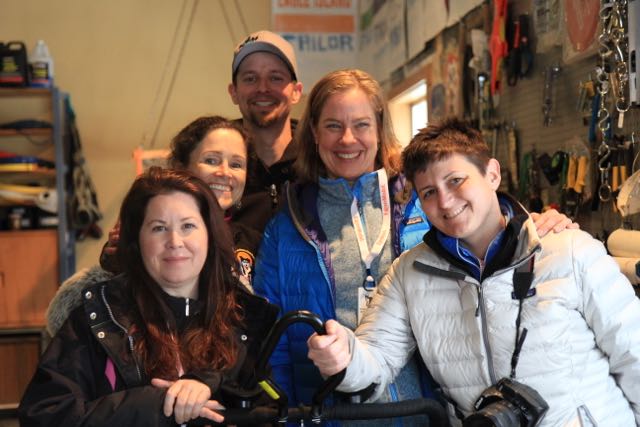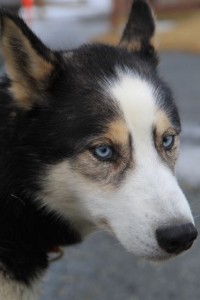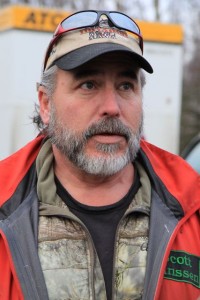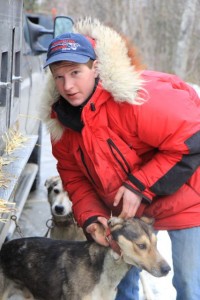Usually it’s the teachers who are taking their students on Field Trips but not on the Wednesday before the start of Iditarod. The Wednesday field trip for teachers attending Iditarod’s Winter Teacher’s Conference is as much of a tradition as Iditarod itself. First stop was Iditarod Head Quarters where vet check was in progress.
One might be surprised at the attire rookie, Brian Wilmshurst, was sporting as he unloaded dogs from his vehicle. With the temperature nudging 40 degrees, it was short’s weather for Brian who resides in Dawson City, Yukon Territory. Think back a couple of weeks when Wilmshurst and 25 other mushers encountered bitter cold temperatures in the Yukon Quest. It was 35 degrees below zero and even colder for most of the race. While he’s a rookie in the 2015 Iditarod, Brian has plenty of experience in the long distance racing. He’s finished four Yukon Quest races and earned his best finish of 10th last year.
- Temperature at Vet Check
- Short’s day for Brian
Rob Cooke, another Yukon Quest Veteran had his Siberian Huskies at vet check early this morning. Cooke’s first experience with Siberians was while living in the United Kingdom where he ran dry land sprint races. In 2005 he moved to North America with nine Siberians. His kennel has expanded to 44 Sibes supervised by one cat. Cooke like Wilmshurst is another survivor of the frozen 2015 Quest. Cooke finished in 16th place claiming the Quest’s Red Lantern. Rob has a goal in mind. If he finishes the Iditarod, he will be the first all Siberian team to complete both 1,000 mile events in the same year. Cooke has a particularly handsome wheel dog named Max. Rob called Max a real character and said he earned the position of wheel dog in order to keep a close eye on him.
- Rob Cooke leads the pack
- Wheel Dog Max
Zoya DeNure was in the Wednesday morning rotation for Vet check. She’s very excited to be back on the trail. Being a mother of two young girls, she’s been very busy but now things have fallen into place to train and run Iditarod. DeNure made a drastic career change years back when she gave up the high life of the Paris fashion runways for a life in Alaska with dogs. DeNure credits Susan Butcher for inspiration and shares the late champion’s love for adventure and animals. Zoya earned her finisher’s belt buckle in 2008 and has also attempted Nome in 2010, 11 & 12. Zoya says her office is outside with canines and nature.
The mushing mortician, Scott Janssen is a very outgoing conversational kind of guy. My first question was about his injury from the 2014 Iditarod. Scott replied his leg was great, better than new but he said, “I crashed a snowmachine recently going 80 miles an hour so I have a few small dings from that.” Wow, I’m thinking how many of your nine lives have you used up? Scott went on to explain, “When you go thousands of miles behind a dog team moving at less than 10 miles an hour, you have to go fast some time.” That seemed to carry through after he won a Dodge Truck in the Iditarod Raffle. He didn’t choose a big sturdy truck to tow his dog trailer; he selected a Dodge Charger capable of going zero to sixty in just a little more than a blink of an eye. The guy likes speed so I wasn’t at all surprised when he mentioned he’d really like to do the Iron Dog some day. Scott has attempted Nome by dog sled 4 consecutive years since 2011. He completed the first two runs. Janssen moved to Alaska in the mid 1980s and has been a mortician and funeral home owner for thirty years. He’s been a friend and sponsor of Paul Gebhardt for the past 17 and that would explain how he found his way to running dogs. His first run to Nome was with Gebhardt dogs. Scott encourages EVERYBODY to purchase Iditarod raffle tickets, after all he won the Charger.
- Scott Janssen
- Ben Harper
Ben Harper, the youngest guy in the race this year, is very mature and knowledgeable about dogs for an 18 year old. Mentored by Ray Redington Jr., one would expect nothing less. Ben has run plenty of shorter races including the Junior Iditarod three times finishing in the top four each year. He and his brother Kevin both participated in the 2014 Junior placing 2nd and 3rd respectively. Ben was second to Conway Seavey by just two minutes. Kevin won the 2015 Junior Iditarod by two minutes over Jimmy Lanier. In the 2014 Junior, Ben received the Humanitarian award for excellent dog care and brother Kevin received the sportsmanship award. Ben’s tutor, Ray Jr., was very proud of the recognition Ben received for excellence in caring for his athletes. While unloading his dogs for the vets, Ben, a man of few words, did say he was very proud of his younger brother Kevin’s victory in the recent Junior Iditarod that ran a distance of 160 miles from Cantwell to Alpine Creek Lodge and back to Cantwell. The ten speedster dogs that Kevin ran will all be on Ben’s Iditarod team. Ben was one of the two free entries awarded to mushers who signed up and stayed at Iditarod Headquarters through the drawing on the first day of musher signup last June. He said he wasn’t absolutely sure about entering The Last Great Race but took winning the entry fee as not just a good omen but also a great one.
There were many more mushers that the teachers had the opportunity to visit with and watch the vets checked over their dogs during the morning. With lunch on the horizon, the teachers headed a few miles down Knik-Goose Bay Road to Settler’s Bay Lodge for a delicious buffet lunch and the opportunity to take pictures of the mountain on the far side of the Cook Inlet. After hearing from a couple of mushers who joined us for lunch the thirty teachers loaded the motor coach for their afternoon adventure.
We headed north on the Parks Highway to Mile 71 and turned on Willow-Fishhook Road. Four miles later we turned on Four Mile Road. A few miles and two ninety-degree turns later, we were at Iditarod veteran, Matt Failor’s 17th Dog Kennel.

Matt with 2016 Iditarod Teacher on the Trail Finalists and 2015 Iditarod Teacher on the Trail Erin Montgomery
Matt is a three time Iditarod Veteran. His trips to Nome were with Martin Buser’s puppy team, Buser’s “B” team and then with his own dogs. Failor has twenty-eight canines that he calls family. They run, train and learn on snow in the winter and do the same on the glacier in the summer at Gold Rush Sled Dog Tours, a business that Matt manages. Mat presented a program for the teachers covering his gear, dogs, breeding program, race strategy and goals for his kennel. One of the sled modifications he and his brother designed is a handlebar addition. They’ve attached a pair of cycling aero bars to the handle bar of the sled. Think about standing on those runners for mile after mile, hour after hour. How good will it feel to bend over, rest your elbows on the pads and stretch out your low back? There will be other drivers who follow suit in years to come.
Where did Failor come up with the name of 17th Dog? Matt has realized that you can’t become competitive in the sport of mushing on your own. It takes the support of a spouse, family, sponsors, fans and friends. To honor everyone who cheers the team on and supports them, Mat decided on the name of 17th Dog. Many of the teachers left Failor’s kennel wearing electric blue t-shirts sporting the 17th Dog logo.
Teachers not only enjoyed the day long field trip immensely but they came away with a sled full of information to use as a foundation for using Iditarod as a theme for education in their classrooms.







































